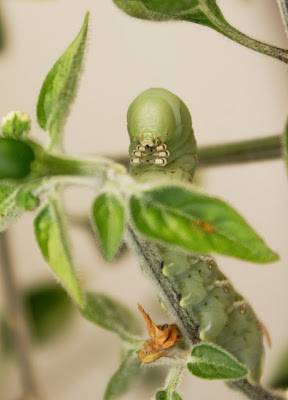
Ruben is justifiably proud of his pepper plant that grows in a pot in my backyard. He started it from seed last year, it gre
 w and overwintered then started growing again as summer 2009 progressed. It now has a large crop of jalapeno-style fruits ready for picking.
w and overwintered then started growing again as summer 2009 progressed. It now has a large crop of jalapeno-style fruits ready for picking.As solanaceae will, the pepper plant has inevitably attracted a Carolina sphinx moth to lay some eggs. Manduca sexta is an attractive large (up to 4 inches or more wingspan) with six pairs of yellow spots on the abdomen. It is also known as the tobacco hornworm in its larv
 al stages, and this one had been hiding out on the pepper plant for some time. These caterpillars grow to be large (over 3" long) but can be surprisingly hard to see on the plant, often giving away their presence if not their exact location by the damage
al stages, and this one had been hiding out on the pepper plant for some time. These caterpillars grow to be large (over 3" long) but can be surprisingly hard to see on the plant, often giving away their presence if not their exact location by the damage they cause and their droppings.
they cause and their droppings.To distinguish them from the very similar tomato hornworm, Manduca quinquemaculata, know that the caterpillars of M. sexta have 7 white backslashes on each side (as opposed to Vs), and a reddish horn which is usually hooked (as opposed to a blackish horn usually straight). I think both species are happy to eat whatever tomato, potato, pepper, datura, and other members of the nightshade family you have been pampering in your garden.
Understandably Ruben was not keen on allowing this hornworm (or its sibling) to stay on as a guest among his beautiful peppers. He squished one of them, but agreed to let me get a few pictures before the 2nd pest met its demise.

6 comments:
A great reason to have chickens! My in-laws used to pick them off & feed them to their chickens.....the ultimate no pesticide pest control!
I've thought about getting a few hens.
Very interesting. Now I know something must have been nibbling at my Salvia. I had hoped those black things were seeds, but likely not. I'll have to investigate...
I think it would be pretty cool to raise a few hens also, problem is I think our cat would love the idea also.
In your cat's dreams! Meanwhile we have a young siamese "Blue Boy" visiting our garden. He lives on the next street and is really very sweet, but still he's a cat.
I have heard that these hornworms can be seen at night by shining a black light on the plants. Haven't tried it tho.
Cynthia
Post a Comment